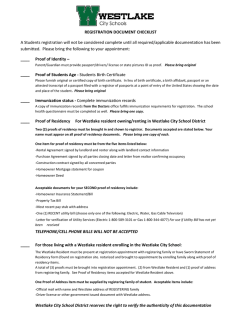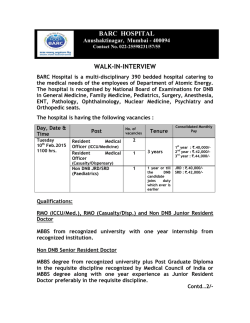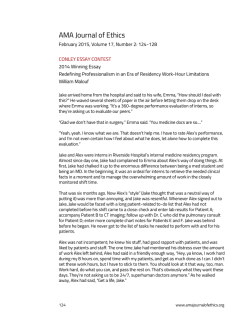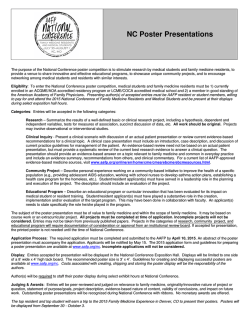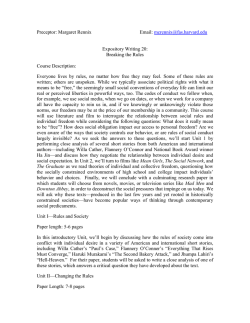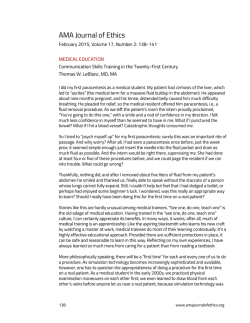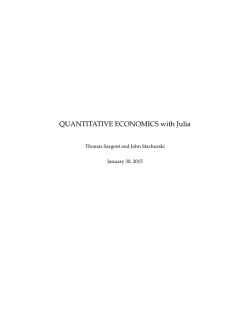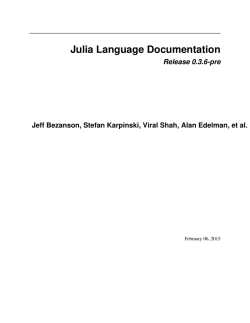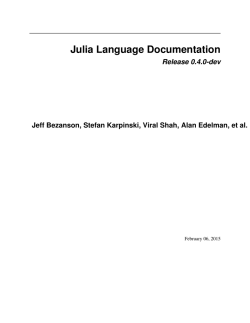
AMA Journal of Ethics - American Medical Association
AMA Journal of Ethics February 2015, Volume 17, Number 2: 116-119 ETHICS CASE Paternity Leave in Medical Residency Commentary by Nathan E. Derhammer, MD Matt is in his second year of residency, as is his wife, Julia. They welcomed a new baby girl into their family just two months ago. Julia had a difficult pregnancy and had to be put on bed rest for two weeks prior to her delivery. Her department advised her to use her vacation time for this bed rest in order to finish her training on time and acquire the experience necessary to score well on her boards. She had originally planned on using it to extend her maternity leave an extra two weeks, but, worried about meeting her program’s requirements and creating resentment among her fellow residents, she decided to return to work after the six-week period. The weeks immediately following her delivery were enormously difficult for Julia, as she tried to take care of a newborn while recovering from a complicated pregnancy. During this time, Matt wanted to take time off to help care for the baby and help Julia, so he requested paid paternity leave from his program. The program denied his request, and Matt and Julia decided it would be best for him to save his vacation and sick days for future emergencies, since Julia had used all of hers. Dr. Smith, an attending physician in Matt’s program, took notice of his situation, thinking that the residency program could have done more. Being a member of the graduate medical education committee (GMEC), he initiated an action to establish a paternity leave option for residents. The proposal sparked heated debate among committee members. Some agreed with Dr. Smith, pointing out that residents in other countries are given more generous options when starting a family, that the number of residents having children is increasing, and that these residents should be given more options and flexibility so that they can lead the balanced lives that will help them be better physicians. Dr. Smith proposed that, until the number of paid residency positions was expanded by the federal government, the program should put pressure on the hospital to hire more physician assistants and nurse practitioners to cover for residents on maternity and paternity leave. His opponents argued that his proposal was unrealistic and that, even if it were possible, it would send a message to the hospital and to the public that doctors can be replaced by people with far less training. Commentary Residency is a rigorous, highly formative stage of professional development for physicians. Within a few years (the particular number is determined by specialty), resident physicians must acquire the practical knowledge and experience to practice competently within their chosen field of medicine. A significant component of this experience is acquired by delivering appropriately supervised patient care at a sponsoring institution. As a result, resident physicians are in the unique position of being both trainees and employees. 116 www.amajournalofethics.org As employees, resident physicians are entitled to salary and benefits. Although far from lucrative, paid work as a resident is often a welcome change from the debt-accruing years of medical school. For many young physicians, particularly those without a significant employment history, access to health insurance and other employee benefits at their training institutions is novel and not always well understood. Of particular relevance to the topic of our case, employment provides resident physicians the opportunity for protected leaves of absence through the Family Medical Leave Act (FMLA) [1]. The FMLA covers parental leave within the first year after the adoption or birth of a child, with continuation of health benefits, which is particularly advantageous to a new parent. It is important for residents in particular to understand that unpaid leave (i.e., any weeks beyond vacation time, sick days, and discretionary time) can impact the length of their training. Resident physicians must complete an accredited residency program to be eligible for board certification in their specialties. Although the recent transition to a milestone-based (rather than competency-based) evaluation process may have future implications for flexibility in length of training, residents taking a leave of absence now must comply with existing accreditation and certification requirements [2]. For example, trainees in procedure-based residency programs are subject to strict requirements regarding the performance of a set number of core procedures. Trainees in non-procedure-based programs must fulfill a required amount of time in particular hospital units and specialties to complete their training. The fulfillment of training requirements often determines how long residency training will need to be extended for a resident who has taken a leave of absence. Another issue is that, given the varied and specific educational requirements of training programs coupled with the institutional patient care needs met by resident physicians, resident scheduling is a highly complex endeavor. Residents on leave do not participate in overnight call, nightfloat, weekend coverage, or the jeopardy/emergency coverage system. In a resident’s absence, scheduling—and, ultimately, patient care—needs are met by his or her peers. Generally, the seamlessness of an individual resident’s absence is directly proportional to the amount of forewarning program leadership receives. Predictable leaves of absence are most readily accommodated through early communication. In our case scenario, Matt should have applied for FMLA leave as soon as possible. Because his request would have been made with less than the preferred 30-day advance notice, he would have needed to assist in establishing coverage of his patient care responsibilities through whatever emergency call-in protocol is used by his residency program. The amount of Matt’s “paid paternity leave” would have been determined by his remaining vacation, sick, and discretionary days for the academic year, but his total FMLA leave could not exceed 12 weeks in a 12-month period. As opposed to acute medical illness or unexpected tragedy, becoming pregnant is often a joyous, carefully premeditated life event and—thanks to a mechanism that is fairly well understood by today’s medical students and residents alike—relatively predictable in its occurrence. Of fortunate benefit to those who may experience the miracle of life in a more surprising fashion, the extended and biologically consistent period of human gestation AMA Journal of Ethics, February 2015 117 often allows adequate time for tailoring of a resident’s schedule to comfortably accommodate a baby’s arrival and a subsequent leave of absence. The earlier a resident parent-to-be communicates with the program director or chief resident, the more flexibly a schedule can adjust to gestational variability or other unanticipated complications. Earlier schedule changes are less bothersome to peers in training and, therefore, highly unlikely to be met with resistance or consternation. Julia and Matt’s predicament is partially due to a lack of appreciation for the gravity of childbirth (and maternal recovery), as well as the parental demands of early infancy. Earlier discussions between Matt and his program director might have created a more favorable climate for short-notice leave. But we should not consider Matt’s request for paternity leave inappropriate. In the era of duty-hour reform and physician burnout awareness, medicine has made important cultural strides towards recognizing the value of maintaining balance between professional and personal life. Additionally, it is impossible to ignore the fact that—much to the perceived disbelief of our predecessors—the joyful and sometimes tragic unpredictability of life is not suspended during residency (or medical school, for that matter). The medical community has also come to acknowledge the vocational value of life-shaping events. There is general understanding that experiencing loss, overcoming acute illness, and coping with chronic disease are all examples of formative experiences that deepen a physician’s empathy and overall emotional intelligence in delivering patient care. Similarly, the rite of passage into parenthood is associated with uniquely challenging (but amazing) maturation, vulnerability, and perspective that enrich one’s insight as a clinician. While the logistical challenge of accommodating leaves of absence requires careful planning, residency programs are well-equipped to meet the needs of their trainees, including those individuals choosing to become parents. References 1. US Department of Labor Wage and Hour Division. Need time? The employee’s guide to the Family and Medical Leave Act. November 2013. http://www.dol.gov/whd/fmla/employeeguide.pdf. Accessed December 18, 2014. 2. Accreditation Council for Graduate Medical Education. Internal medicine subspecialty reporting milestones: frequently asked questions. http://www.acgme.org/acgmeweb/Portals/0/PDFs/Milestones/InternalMedicineS ubspecialtyMilestonesFAQs.pdf. Revised March 6, 2014. Accessed December 18, 2014. Nathan E. Derhammer, MD, is the program director of the Combined Internal Medicine and Pediatrics Residency Program at Loyola University Medical Center in Maywood, Illinois, where he completed his own residency training. His academic interests include medical student and resident education, leadership activities, and faculty development. Related in AMA Journal of Ethics Bias Against Pregnant Medical Residents, July 2008 Pregnancy and Parenthood in Residency, September 2003 118 www.amajournalofethics.org Redefining Professionalism in an Era of Residency Work-Hour Limitations, February 2015 Duty-Hour Exceptions for Neurosurgery Residency Programs, January 2015 The people and events in this case are fictional. Resemblance to real events or to names of people, living or dead, is entirely coincidental. The viewpoints expressed in this article are those of the author(s) and do not necessarily reflect the views and policies of the AMA. Copyright 2015 American Medical Association. All rights reserved. ISSN 2376-6980 AMA Journal of Ethics, February 2015 119
© Copyright 2025

